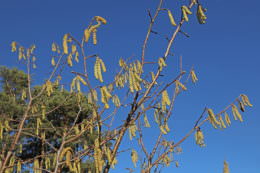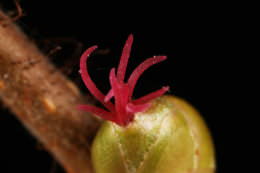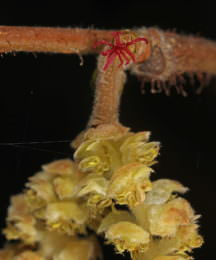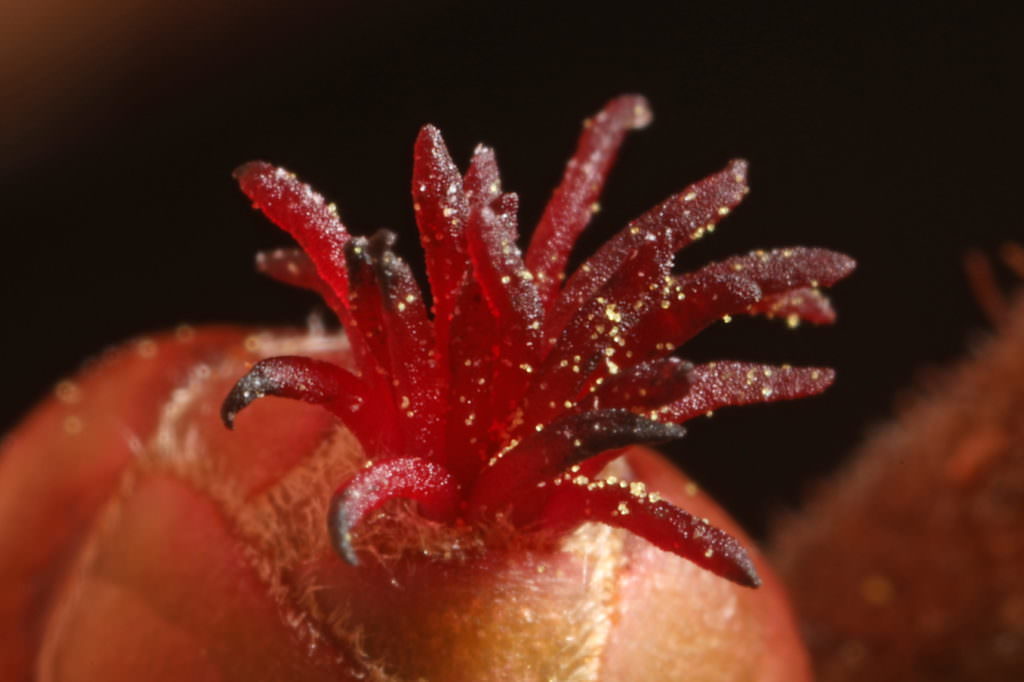
Catkins on a young hazel tree on the south side of Wilkie’s Wood on 1st March 2021.
By Alan Featherstone Watson
This is another of my occasional articles about the biodiversity of the Findhorn Hinterland area, this time about hazel trees in spring. After the snow melted in the middle of February, the warmer weather has really accelerated the coming of spring, and many people will have noticed one of the first signs of this – the plentiful catkins on hazel trees. These open out (from the catkin buds that formed last year) well before the new leaves appear, and are the male flowers of the hazel, producing abundant pollen which is dispersed by the wind.

Female flower on the hazel tree on 1st March.
Much less obvious, and less well-known perhaps, are the female flowers. These are tiny red structures with numerous curved dark red ‘fingers’ that emerge from the top of special buds on the hazel’s twigs. They are easily missed as they are quite inconspicuous, so it can require careful searching to find them. They are often positioned slightly further back on the twigs than the catkins, and usually not too close to them.

Here, a female flower is very close to catkins, showing the difference in size between them.
Hazel is self-incompatible, meaning that an individual tree cannot pollinate itself, and instead requires pollen from another tree for fertilisation and subsequent hazelnut development to take place. Despite its early flowering, the act of fertilisation does not occur in hazel for several months, as the ovaries only begin to develop in the female flowers after pollination has taken place.
Hazel is an important native tree species, and its nuts are relished by red squirrels, mice and various birds such as woodpeckers. The Findhorn Hinterland Trust has been planting hazels as part of our work to diversify the Wilkie’s Wood and Fallen Acres areas. Their catkins and female flowers will be visible for another week or two, so have a close look and enjoy some of the first blossoms of spring.

Female flower of the hazel with pollen grains on it.

















Hinterland Hazel
Catkins on a young hazel tree on the south side of Wilkie’s Wood on 1st March 2021.
By Alan Featherstone Watson
This is another of my occasional articles about the biodiversity of the Findhorn Hinterland area, this time about hazel trees in spring. After the snow melted in the middle of February, the warmer weather has really accelerated the coming of spring, and many people will have noticed one of the first signs of this – the plentiful catkins on hazel trees. These open out (from the catkin buds that formed last year) well before the new leaves appear, and are the male flowers of the hazel, producing abundant pollen which is dispersed by the wind.
Female flower on the hazel tree on 1st March.
Much less obvious, and less well-known perhaps, are the female flowers. These are tiny red structures with numerous curved dark red ‘fingers’ that emerge from the top of special buds on the hazel’s twigs. They are easily missed as they are quite inconspicuous, so it can require careful searching to find them. They are often positioned slightly further back on the twigs than the catkins, and usually not too close to them.
Here, a female flower is very close to catkins, showing the difference in size between them.
Hazel is self-incompatible, meaning that an individual tree cannot pollinate itself, and instead requires pollen from another tree for fertilisation and subsequent hazelnut development to take place. Despite its early flowering, the act of fertilisation does not occur in hazel for several months, as the ovaries only begin to develop in the female flowers after pollination has taken place.
Hazel is an important native tree species, and its nuts are relished by red squirrels, mice and various birds such as woodpeckers. The Findhorn Hinterland Trust has been planting hazels as part of our work to diversify the Wilkie’s Wood and Fallen Acres areas. Their catkins and female flowers will be visible for another week or two, so have a close look and enjoy some of the first blossoms of spring.
Female flower of the hazel with pollen grains on it.